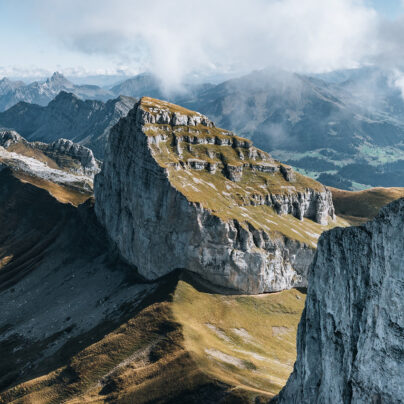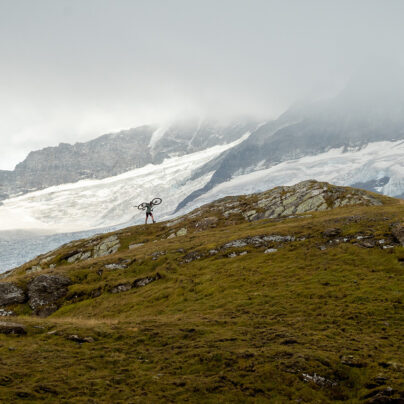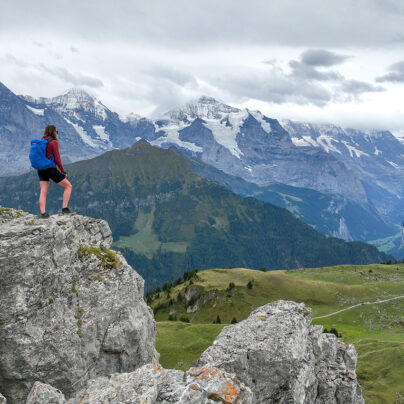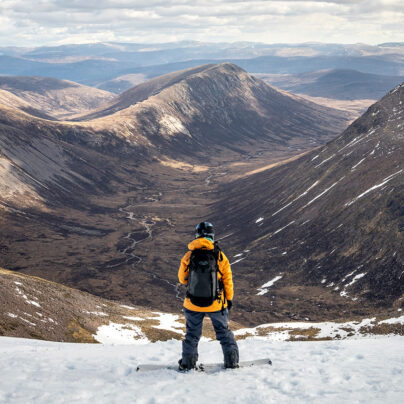Of Dreams and Daily Bread
An Adventure in Applecross
Written by Stefan Durkacz // Photography by David Lintern
It’s been a long year, and the weight of it all seems to press my head to the passenger side window, force down my eyelids, and stop my words at the source. There’s more to this feeling than the 5.00am wake-up call.
Mick is in the back and David is at the wheel. After many months we’re picking up the threads of our once-regular adventures together, navigating our way to the Applecross Peninsula in the North-West Highlands. It’s billed as one of the remotest parts of Scotland, belonging to the mainland but an island in spirit, its Atlantic-facing settlements accessible only by boat or tenuous single-track roads. But to describe such a place as ‘remote’ is perhaps a little pejorative: remote from what, after all? Applecross, as we’d find, as we always find, has its own stories to tell.
Since our last meeting a certain virus has turned our worlds upside down. Life has forced its way through the artificial stasis of lockdowns, its blind imperatives not letting up for a minute. In the last year David has dealt with close bereavement. Mick, a senior nurse in Glasgow, has worked long and difficult hours on the front line of the pandemic.
For me, problems were more of the first-world variety. I had work and my family around me. But still, sometimes you don’t feel the pressure until it’s released and now, further from home than I’ve been in months, I can suddenly see it all – the fraught home schooling, the equally fraught home working, the wondering when, or if, it will ever end. The slow realisation that there can be no back to normal. I feel tired. We all do.
Maybe escapism can never be the same again, either. Travelling familiar roads north, the usual anticipation is edged aside by uneasy wonder. From the cities to the mountains, we’ve all been through a near-unprecedented upheaval. How have the people who live here coped? Stories have echoed down the social-media grapevine – first of no visitors and livelihoods trashed, then a flood of visitors and communities overwhelmed, the edges of conflict sharpened on a constant grindstone of stress and uncertainty that many of us in the developed world have forgotten how to live with. Here at least, we take the security of everyday life as given. The pandemic has pulled back the awnings enough to glimpse how rickety our shared structure is – and given it a few good kicks into the bargain.



Perhaps that’s why this trip felt a little like looking at one of those pictures where the mind slides between two interpretations, scrabbling for balance – do you see the rabbit or the duck, the vase or the two faces in profile? For me, these are places of escape, of beauty, where something other than humanity is centre stage. But Applecross is also a place of work and livelihood, layered with stories, bearing everywhere the mark of centuries of human life and adaptation. It is home as well as escape.
***
On the final winding miles from Lochcarron village, the Applecross mountains loom large across Loch Kishorn, a steep and sudden barrier. Beyond this upthrust lie miles of rugged upland, falling away westwards to the ancient coastal settlement of Applecross, the open sea, and the distant Hebrides. These mountains share the same geological heritage as the more famous Torridon hills: eerily regular sandstone terraces, bulging barrel-shaped buttresses, and deep corries spliced by pinnacled ridges.
We unfold ourselves from the car where the River Kishorn meets the sea loch, the air pungent with seaweed and saltmarsh. Across the estuary, Rassal Wood, Britain’s most northerly natural ash woodland, is still a grey haze of bare branches. It’s the last day of April.
The road to Applecross village starts here – a narrow singletrack affair that soon peels away from the lochside into the huge cliff-ringed amphitheatre of Coire na Bà. Bealach na Bà, or pass of the cattle, was originally a droving route. Nowadays it’s renowned as ‘Britain’s most dangerous road’, and is the crux of the North Coast 500 driving route. Every summer sees streams of campervans, sports cars, and motorbikes tackling the 180° switchbacks and near-20° gradients to reach the road’s summit, 2,053ft above sea level. The summer invasion brings both income and problems in its wake for the communities along the route, sustaining businesses but causing congestion and environmental problems. The post-Covid rush saw acute pressures: fires, litter, and irresponsible camping, layered over pre-existing local concerns.
We wanted to avoid using the road to reach the foot of our first objective, Sgùrr a’ Chaorachain, its massive prow flanked by cliffs. Micro-navigation. After a kilometre or so we’d hoped to find a track climbing up to our mountain but instead found ourselves by a blank-walled building housing a mini-hydro turbine. Back at the entrance to a recycling centre, our confused wanderings had attracted the attention of a youngish man who politely let us know there was no through route. Nothing for it but to take to the open hillside. Soon enough we hit our track: overgrown and clearly ancient but expertly made, hugging the contours, taking the least steep line possible, and avoiding the boggiest hollows. Far up the hillside it merged with the modern road. This may have been the original line of the Bealach na Bà approach, fit for slow-moving horse-drawn carts, a little too steep for motor vehicles.



We crossed the road and began our climb in earnest up the ever-steepening prow. High above Loch Kishorn, the gulf of air between was suffused with golden light. A small ship slid silently across the glassy water towards the Kishorn port, just along from that industrial zone we’d walked through. Originally developed for building oil platforms in the early 1970s, the story of the Kishorn yard exemplifies the tensions between conserving and protecting the Highlands’ natural assets and the needs of local people for skilled work, reasons to keep their young people and maintain and improve their communities. The late Tom Weir, a giant of 20th-century outdoors culture in Scotland, visited Kishorn during the latter stages of the yard’s construction in 1975 and wrote about it in The Scots Magazine. He quotes an elderly local resident: ‘The noise [of construction] goes on all the time, but we think nothing of it… Better that than nothing, and nothing is what we have had here for too long.’
Weir was a sort of polymath outdoorsman typical of his generation: hiker, climber, Himalayan explorer, birdwatcher, conservationist. He was also a child of Depression-era Glasgow who probably had a good grasp of people’s needs in the round, of the body as well as the soul. On Kishorn, he was open-minded: ‘I had come to look at the big platform yard and, expecting the worst, was agreeably surprised by how miniscule it looked against the big scale of the Torridonian sandstone country which dwarfed the cranes and the steelworks of the distant shore. Even the work camp and recreational complex were hard to pick out against the rocks.’
Pausing for breath, I’m a bit behind the others, still grinding my gears. I look up at their silhouettes on the skyline, then down at the industrial strip along the coast. Tom was right, I think – it’s dwarfed by the vastness of mountain, sea, and sky. There’s also an uncomfortable feeling of tenuousness, a sense of another fragile iteration of the human will to survive and thrive here set against a relatively unchanging and vastly indifferent landscape. Maybe it’s an expression of faith, not so different from when the Irish monk Maelrubha founded his monastery on the other side of the peninsula in 673. That lasted 120 years before it was sacked and destroyed by Viking raiders. Close up, 120 years seems like a long time. From this distance, not so much.
***
The light is failing. That huge climb is behind us and we’re walking a winding path along the neck of ridge connecting Sgùrr a’ Chaorachain’s summit dome to the broader upland massif. Chill and gloom overlay the deeper tiredness; we’re all feeling that instinctive pull to seek shelter for the night. The knobbly crest hides some grassy nooks but there’s no water up here.



We push on above twin voids. Far below on the left, the road toils up Coire na Bà, but it’s the view right across Coire na Chaorachain that snags our attention. The Cioch Ridge, Na Ciochan, rears up from the moor, a Godzilla-like spine of steps and pinnacles flanked by sheer, terraced rock. This is climbers’ country, and the Cioch is a famous route. It was first climbed in 1960 when Ullapool GP and legendary Scots climber Tom Patey persuaded Chris Bonington to join him. The story goes that the climb, whilst scenically magnificent, proved less tricky than Patey anticipated. Referencing the route’s ‘Difficult’ climbing grade, he later quipped that it was ‘the Diff to end all Diffs’ and gave ‘the best value for Difficult’ in Scotland. We non-climbing backpackers can only reach out across the gulf with eyes and minds, feeling an echo of the route in uneasy stomachs and a brief giddiness.
Tearing ourselves away, we toil up and over Sgùrr a’ Chaorachain’s subsidiary top in the half-light, where a TV transmitter mast stands incongruously at the end of a gravel track snaking up the hill from the Bealach na Bà. Night closes over us as we hit difficult ground. I raise a silent, self-pitying reproach to the cosmos when I find my head torch is dead, and no amount of fumbling with different combinations of spare batteries can revive it. I follow the unsteady beams of the others down and down, over a long series of terraces, creeping, peering, feeling for the weakness in the rock then slithering down to the next ledge of turf – then again, and again. There’s a vague sense that those terraces eventually lead out over a void to the right, adding a further complicating variable to the mix. Keeping your overall sense of direction in the dark is hard.
At last, we reach easier ground. The torch beams pick out a tiny lochan cradled in a hollow. Groping amongst tussocks and mush and rocks, trying to judge the slope with our feet, we each find a pitch eventually. It’s close to midnight and I’m ready to crumple into my sleeping bag, but force myself through the routine of dry socks, cooking, eating, cleaning teeth. As sleep swallows me up, I feel months of tension slip from shoulders somewhat. When something has to give, the hills can have a way of making it happen. I hope for lighter feet and a brighter mind in the morning.
Fatigue makes a good mattress. We emerge from our shelters in the early light, dipping water bottles into the lochan, fixing breakfast. That lochan has a pure, mirror-like quality that invites touch. Out near the middle a large angular rock stands on its end. The terrain is harsh; we see now that we were lucky to find tent-sized spaces amongst the bare bedrock.


Today feels less like hard work and everything seems to flow. We work our way around the head of Coire nan Arr, aiming for Beinn Bhàn, the highest summit in Applecross. The broad back is turned to us, hunched high over hidden corries like a drinker lost in reverie over a glass. Three terraces curve around the corrie headwall towards the bealach and the long slopes of Beinn Bhàn; we pick the middle one. Our choice is vindicated when we find the remains of a deerstalker’s path, which we follow across the bealach and up the far side until it peters out. Beinn Bhàn is a rolling plateau of rough grass, no doubt prime red deer grazing.
It’s overcast, breezy but dry as we walk the easing slopes to the skyline, revelling in the sense of height and space. There’s the cairn, the trig point, and suddenly we hit the edge. Coire na Poite, hollow of the pot, its little lochans like the dregs of the glass, 1,000ft below us. I feel the height first rather than see it, feel it register in the lurch of the stomach and catch of the breath. Then the eyes take over, trying hopelessly to piece it together from corrie floor to lip – aprons of talus, crags upon crags, walled by another soaring, stepped ridge. I have to move back before I can grasp it all.
Beinn Bhàn’s broad ridge-cum-plateau is a world unto itself with its own topography, circumscribed always to our right by the deep bites of successive corries. It reminds a little of the Cairngorms far to the south-east, but the outlook is unmistakeably west coast. The walking is easy and carefree as we wander towards the sunlit open sea and the Hebrides on the edge of sight. I sense the island feel of Applecross now, where that feeling of separateness comes from, a great slab of mountain and coast tethered to the brooding, clouded mainland behind us but straining always for the bright ocean. I want this part of the walk to go on and on.
Beyond the last east-facing corrie, the crags gradually peter out. We descend steep grass and double back, bending south across the open hillside, Loch Lundie to our left and above us to our right the awesome east face of Beinn Bhàn with its dark recesses and swelling, terraced buttresses. Our line descends gently as the shadows lengthen. Mick, a little ahead, finds a dry acre of yellow grass beside a little burn and with comical timing is illuminated by a Biblical shaft of sunlight. David and I laugh out loud. The heavens have spoken – we must camp here!
It’s a joy to pitch in benign conditions in a perfect spot and with plenty of daylight to spare. The evening whiles away with dinner, drams and chat, and the morning is equally leisurely. There are only a few miles to go now, all downhill. We soon drop into the glen floor and a secretive area of reedy lochans. A sturdy rowan grows out of a fissured outcrop where the hungry deer can’t reach. Deer stalking is still part of the economy here and numbers are high, their trods and droppings everywhere on this near-treeless landscape. As elsewhere throughout the Highlands, fewer deer would have a dramatic impact on this landscape, allowing scrub and forest to return.
We stop for an early lunch and brew by one of the lochans where the breeze ruffles the water below dark mountainsides. Any remaining tensions we’re carrying are dissolved, or at least set aside. We swap family tales of home: the losing of it, the searching for it, and the making of a new one through that human alchemy of luck and willpower. Time falls away for a little while as the stove hisses and the tales unfold and meander.
As we gather up our things for the last miles back, it strikes me. I came with brittle ideas of escape, a notion to outwalk the crusted anxieties of the last year, to apply old solutions to a new set of troubles. I knew what I thought I wanted, but the mountains of Applecross in their deep age and complexity, space and stillness pointed out the gaps in my map and showed me what real escape is: not running away but coming back to yourself, not breaking off but reconnecting. The mountains are a place of both dreams and daily bread: I can hold that in my head again.
Written by Stefan Durkacz // @spdurkacz
Photography by David Lintern // @davidjlintern // davidlintern.com








